Seven Must-See Art-Meets-Science Exhibitions in 2013
Preview some of the top-notch shows—on anatomy, bioluminescence, water tanks and more—slated for the next year
![]()
This New Year’s Eve, in addition to the typical resolutions to exercise more or spend more time with family, consider resolving to take better advantage of the cultural offerings of America’s cities and towns. Whether you seek to attend concerts, listen to lectures by authors and visiting scholars or become regulars at area museums, a few exhibitions slated for 2013 on the intersection of art and science will be must-sees in the New Year.
The Water Tank Project
The skyline of New York City will be transformed next summer when 300 water tanks in the five boroughs become public works of art, calling attention to water conservation. Artists, including Jeff Koons, Ed Ruscha, Catherine Opie, Lawrence Weiner, and even Jay-Z, have agreed to participate in the project. Their original designs will be printed on vinyl, which will be wrapped around the mostly wood tanks, which typically measure 12 feet high and 13 feet in diameter, perched on top of buildings. The art will be a welcome addition to the city’s rooftops, while also providing more awareness of the global water crisis.
Teaching the Body: Artistic Anatomy in the American Academy, From Copley, Eakins, and Rimmer to Contemporary Artists
Naomi Slipp, a PhD candidate in art history at Boston University, is organizing an ambitious exhibition of more than 80 sketches, models, prints, books, paintings and other works that tell a full story of artistic renderings of human anatomy in America. On display at the Boston University Art Gallery at the Stone Gallery, from January 31 to March 31, the exhibition spans two and half centuries, from the very first anatomy text by painter John Singleton Copley, dating to 1756, to works by contemporary artists, such as Lisa Nilsson, who creates paper sculptures depicting cross sections of the human body. ”This exhibition examines both what that study of artistic anatomy meant for these artists and for the way we, today, think about our own bodies and how they work,” said Slipp, in her successful bid to raise funds for the project on Kickstarter. ”In looking at artworks created by artists and doctors, I hope to unite this diverse audience, bringing together people who are interested in art and those who are interested in medicine for a rich, shared conversation about what it means to occupy, treat and picture our own bodies.”
Portraits of Planet Ocean: The Photography of Brian Skerry
“I believe my most important role remains as artistic interpreter of all that I see. I need to understand the science, but I want to capture the poetry,” writes Brian Skerry, in his book, Ocean Soul. A National Geographic wildlife photographer with decades of experience, Skerry has captured enchanting portraits of harp seals, Atlantic bluefin tuna, hammerhead sharks, beluga whales, manatees and other creatures of the deep. His line of work requires loads of equipment—underwater housings for his cameras, strobes, lenses, wetsuits, drysuits, fins—to get the perfect shot. “While no single image can capture everything, in my own work I am most pleased when I make pictures that reveal something special about a specific animal or ecosystem, pictures that give viewers a sense of the mysterious or in effect bring them into the sea with me,” says Skerry, in a dispatch on Ocean Portal. Earlier this fall, Ocean Portal asked the public to vote for a favorite among 11 of Skerry’s photographs. The viewers’ choice and other images by the underwater photographer will be on display at D.C.’s National Museum of Natural History beginning April 5.
American Vesuvius: The Aftermath of Mount St. Helens by Frank Gohlke and Emmet Gowin

Inside Mount St. Helens Crater, Base of Lava Dome on the Left (detail), by Frank Gohlke, 1983. Courtesy of The Cleveland Museum of Art.
On May 18, 1980, stirred by a 5.1 magnitude earthquake, Mount St. Helens in Washington state’s Cascade Range erupted, forever changing the landscape surrounding it. Separate from one another, American photographers Emmet Gowin and Frank Gohlke documented the devastation (and in Gohlke’s case, the gradual rebirth) of the area. The Cleveland Museum of Art is bringing the photographers’ series together, side by side, in an exhibit, on display from January 13 to May 12.
Interestingly, the museum will also play host to “The Last Days of Pompeii: Decadence, Apocalypse, Resurrection,” looking at art by masters ranging from the 18th and 19th century artists Piranesi and Ingres to more modern contributions from Duchamp, Rothko and Warhol, all inspired by the deadly eruption of Mount Vesuvius in AD 79. The exhibit will be on display from February 24 to May 19.
Gogo: Nature Transformed
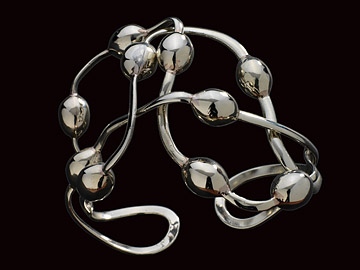
Maine seaweed cuff, 2008. Designed by Gogo Ferguson and Hannah Sayre-Thomas. Photo by Peter Harholdt.
Gogo Ferguson and her daughter, Hannah Sayre-Thomas, live on Cumberland Island, off the coast of Georgia. Morning, noon and night, the pair walks the beach, collecting interesting skeletons, seaweed and seashells brought in by the tide. “Nature has perfected her designs over millions of years,” writes Ferguson, on her Web site. And so, the artist incorporates these organic designs into jewelry, sculptures and housewares. Her first museum exhibition, at the High Museum of Art in Atlanta from January 19 to July 7, features more than 60 works, including a six-foot by eight-foot wall sculpture modeled after seaweed from New England and an ottoman fashioned after a sea urchin.
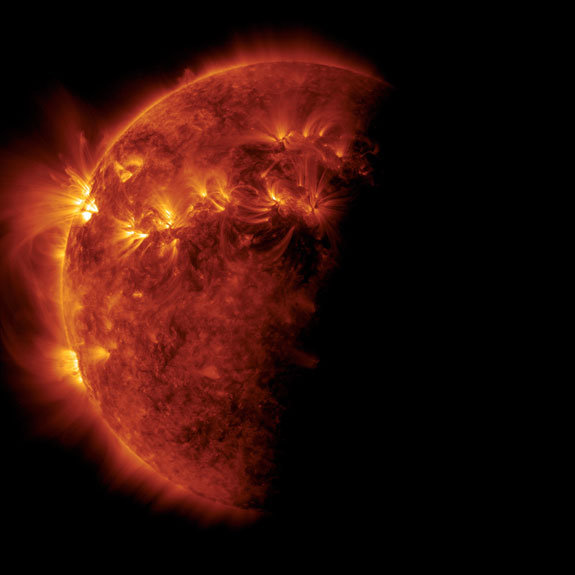
View of the solar corona and magnetic loops during an eclipse of the Sun by the Earth. Solar Dynamics Observatory, April 2, 2011. Credit: NASA GSFC/Michael Benson/Kinetikon Pictures.
Michael Benson
Photographer Michael Benson takes raw images collected on NASA and European Space Agency missions and enhances them digitally. The results are brilliant, colorful views of dust storms on Mars and Saturn’s rings, among other sights. The American Association for the Advancement of Science Art Gallery in Washington, D.C. will be exhibiting images from Planetfall, Benson’s latest book, as well as his other titles, including Far Out: A Space-Time Chronicle (2009) and Beyond: Visions of the Interplanetary Probes (2003), from mid-February through the end of April.
Creatures of Light: Nature’s Bioluminescence
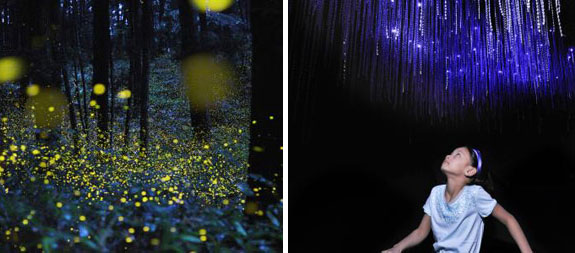
(Left) Firefly signals captured in slow-shutter speed photos. © Tsuneaki Hiramatsu. (Right) A re-creation of New Zealand’s Waitomo cave system, with sticky “fishing lines” dropped from the ceiling by glowworms. © AMNH\D. Finnin.
If you missed it at New York’s American Museum of Natural History this past year, there is still time to see “Creatures of Light: Nature’s Bioluminescence” at its next stop, Chicago’s Field Museum, from March 7 to September 8. The exhibition highlights the diversity of animals, from fireflies and glowworms to jellyfish and fluorescent corals found upwards of a half-mile deep in the ocean, that use bioluminescence, and the variety of different reasons for which they do. A firefly, for instance, glows to catch the attention of a mate. An anglerfish, meanwhile, attracts prey with a bioluminescent lure dangling in front of its mouth; a vampire squid releases a cloud of bioluminescence to befuddle its predators. The show also explains the chemical reaction that causes the animals to glow. “The one real weakness,” wrote the New York Times, at the opening of the exhibition at the American Museum of Natural History, “is that with only a few exceptions—like the tanks of blinking ‘splitfin flashlight fish’ found in deep reefs of the South Pacific—this is not an exhibition of specimens but of simulations.”
/https://tf-cmsv2-smithsonianmag-media.s3.amazonaws.com/accounts/headshot/megan.png)
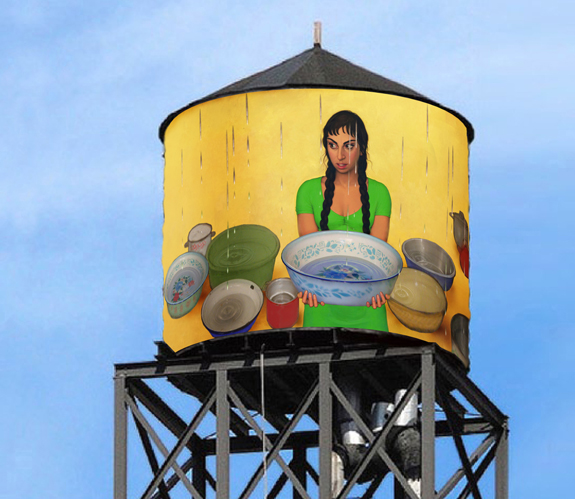
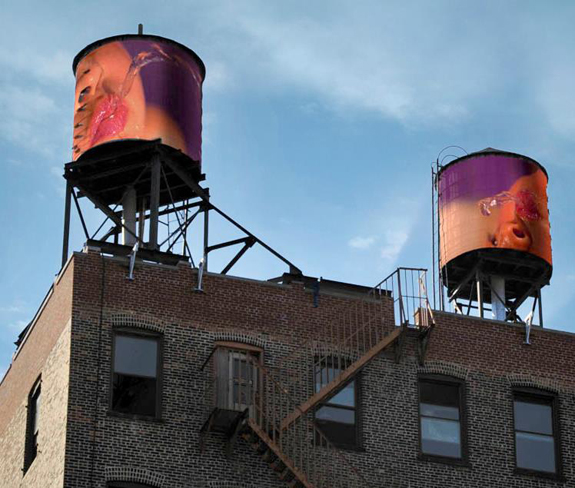
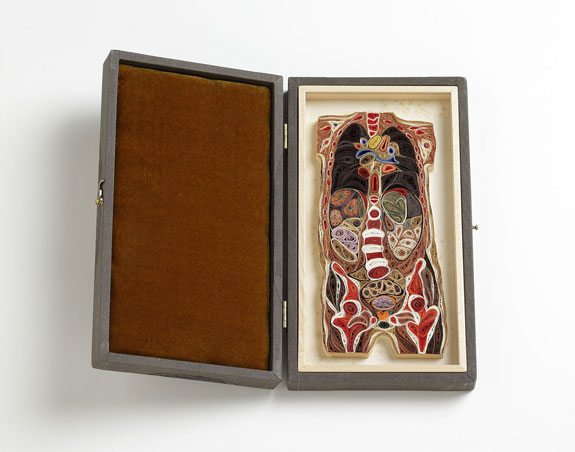

/https://tf-cmsv2-smithsonianmag-media.s3.amazonaws.com/accounts/headshot/megan.png)